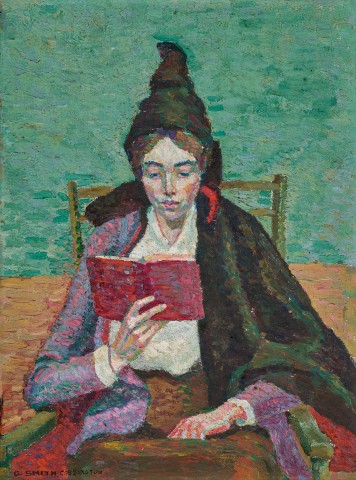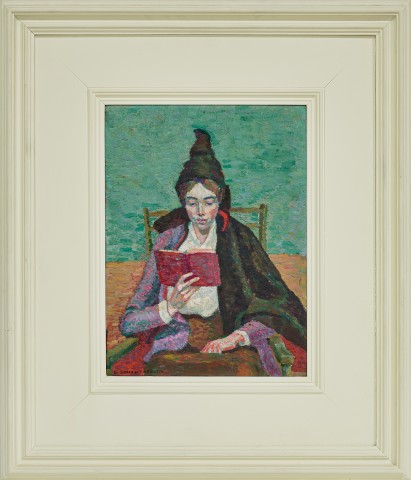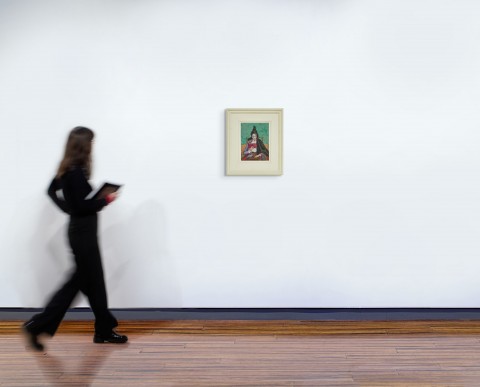(1892 - 1984)
Grace Cossington Smith
The reader (the school cape), c.1916
oil on canvas on pulpboard
Professor Bernard Smith, Sydney, acquired directly from the artist, c.1960
Sotheby's, Melbourne, 17 April 1989, lot 454 (as ‘The School Cape’)
Private collection, Melbourne
Grace Cossington Smith Retrospective, Art Gallery of New South Wales, Sydney, 15 June – 15 July 1973, then touring to: Queensland Art Gallery, Brisbane, 6 September - 4 October 1973, Western Australian Art Gallery, Perth, 6 December - 2 January 1974, Art Gallery of South Australia, Adelaide, 11 January - 10 February 1974, National Gallery of Victoria, Melbourne, 26 March - 28 April 1974, cat. 3 (label attached verso)
A century of Australian Women Artists 1840s - 1940s, Deutscher Fine Art, Melbourne, 4 June - 3 July 1993, cat. 90 (illus. in exhibition catalogue, p. 22)
Thomas, D., Grace Cossington Smith, Art Gallery of New South Wales, Sydney, 1973, pl. 3, pp. 9, 15 (illus., as ‘The School Cape’)
James, B., Grace Cossington Smith, Craftsman House, Sydney, 1990, pl. 6, pp. 37 (illus.)
The reader, 1916, oil on canvas, 51.2 x 40.6 cm, Art Gallery of New South Wales, Sydney
Grace Cossington Smith’s The reader (the school cape), c. 1916, is a jewel of a painting which dates from the dawn of modernism in Australia. It is also one of the very few from that time still in private hands. Although it was not until 1940 that a work by the artist entered a state gallery collection1, there is no institution now that does not proudly own at least one example. Such is her importance that the National Gallery of Australia currently lists 1,721 paintings, drawings, watercolours and sketchbooks by Cossington Smith in their collection – a remarkable number that underscores this opinion (by comparison, there are only 469 by Sidney Nolan). Also remarkable is that she had only been painting for one year when she created The sock knitter, 1915, recognised as this country’s first truly modernist piece of art. The reader (the school cape) was painted the following year and displays an even richer celebration of colour – that one true passion lying at the heart of her extensive oeuvre spanning sixty-one years.
Cossington Smith was part of a closely entwined family, and her early portraits were of her parents and siblings. Younger sister Madge was the model for The sock knitter and also for The reader (the school cape), in which she wears ‘a hooded cape which had been part of Grace’s school uniform at Abbotsleigh, Wahroonga’2 – a progressive girls’ school where she received basic training from the artists Albert Collins (who would soon become a director at renowned advertising firm Smith and Julius), and Alfred Coffey (a winner of numerous awards over previous decades when exhibiting with the Royal Art Society of New South Wales). On leaving Abbotsleigh, the headmistress Marion Clarke gave Cossington Smith a farewell gift of art books, and the next year she enrolled in drawing classes run by the flamboyant Neapolitan, Antonio Datilo-Rubbo, at his Sydney atelier in Pitt Street. In 1912, she travelled to Europe with her elder sister Mabel where, in England, she attended drawing classes at the Winchester School of Art before travelling to Stettin, Germany (now Szczecin, Poland) staying with relatives of their mother. Here, Cossington Smith attended ‘a dozen outdoor sketching classes’3 at the town of Speck, even though it was over 100 kilometres from Stettin; the reasons for this choice are unknown. The sisters returned to Sydney in 1914 and Cossington Smith re-enrolled in painting classes with her former teacher, now based in Rowe Street. Unbeknownst to her, Rubbo had experienced a revelation in her absence. A former student Norah Simpson had returned to his classes the previous year following study in London under the noted British post-impressionists Harold Gilman and Spencer Gore. Significantly, she brought with her a collection of colour reproductions featuring a range of artists’ paintings, including those by Cézanne, Gauguin and van Gogh. By the time Simpson left Sydney again in May 1915, Rubbo was fired with enthusiasm for these new ways of seeing.
Also inspired was Cossington Smith and her fellow students Roy de Maistre, Roland Wakelin and Constance Tempe Manning. They were, however, now considered ‘wild animals’ (fauves) as far as the arbiters of local art were concerned and numerous of their more ambitious entries were rejected from RAS exhibitions (the fiery Rubbo even threatened to duel one RAS judge over an excluded submission by Wakelin). The four students began exploring emotive, high-pitched colour, using divided paint marks within a flattened plane. Although The sock knitter is relatively subdued in this regard, the model’s face and hands are coloured with blues, pinks, greens and caramel, and even the large passages of violet in her cardigan are not ‘flat crude colour, (instead, there is) colour within colour, it has to shine; light must be in it, it is no good making heavy, dead colour.’4 A similar work, also titled The reader, 1916 (Art Gallery of New South Wales) features younger sister Charlotte (also known as Diddy) sitting in a chair in Grace’s bedroom, and here, the ‘shining’ light and colour is even more evocative.
The reader (the school cape), by comparison, almost explodes with pigment intensity. Set within two distinct planes, one in shades of aquamarine, the other of orange-brown, Madge reads a book (itself executed in horizontal brushstrokes of red, blue and violet) whilst wearing the same cardigan as in The sock knitter, only this time the colouration contains pinks, blues and ultramarine. Her hands and face pulsate with at least five distinctly different colours, but are offset in places against an olive-green ground, which indicates the artist’s knowledge of similar techniques used by Renaissance painters when depicting flesh. The composition too is startling despite the relative simplicity of the pose, as the ruched hood of the Abbotsleigh cape creates a dynamic and unusual apex, the visual ‘weight’ of which is countered by a flash of red near the sitter’s neck. Though small, The reader (the school cape) rewards any repeat viewing.
A final point involves the signature. ‘Cossington’ was the name given to two houses occupied by the family and ‘came from the ancestral home of the artist’s mother: Cossington Hall in Leicestershire, Great Britain.’5 The first, where the artist was born, was built by her father in c. 1888 in Neutral Bay, Sydney.6 The second, in Turramurra, was initially named ‘Sylvan Falls’ when rented by the family from 1914, before its purchase and re-titling to ‘Cossington’ in 1920. From about 1919, at her mother’s suggestion, the artist began using ‘Cossington’ within her signature ‘as part of her identity as an artist.’7 This transition is shown in The reader (the school cape). The first part of the signature ‘G. Smith’ dates from c. 1916, but its addendum ‘Cossington’ was clearly painted at a different stage. It may have been added during the process of the painting’s sale to the noted art historian Dr Bernard Smith, but with this one small detail, Cossington Smith marks her own strategic progress from extraordinarily talented student to mistress of her own artistic identity.
1. In 1940, a group of twenty subscribers bought a still life by the artist and presented it to the Art Gallery of New South Wales.
2. Thomas, D. R., Grace Cossington Smith, Art Gallery of New South Wales, Sydney, 1973, p. 9
3. ibid., p. 69
4. Grace Cossington Smith, interviewed by Hazel de Berg, 16 August 1965, in Hazel de Berg collection, National Library of Australia, Canberra, DeB 122
5. Hart, D. (ed.), Grace Cossington Smith, National Gallery of Australia, Canberra, 2005, p. 1
6. This property originally opened on to Wycombe Road but has since been sub-divided. The main house now fronts 70 Shellgrove Road.
7. Hart, op. cit., p. 1
ANDREW GAYNOR


